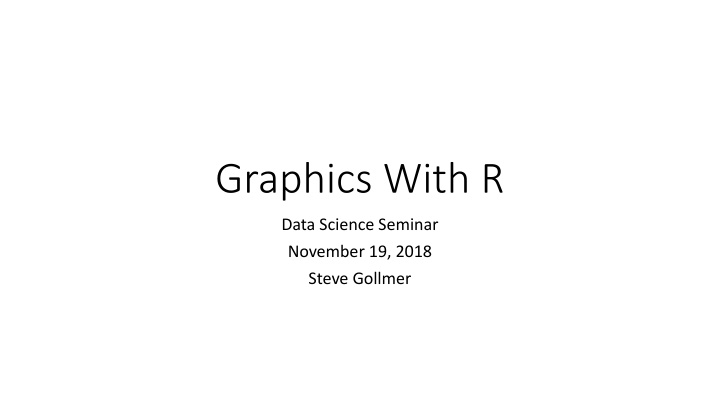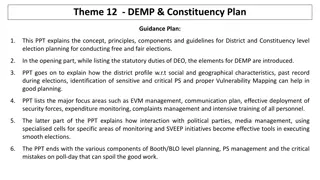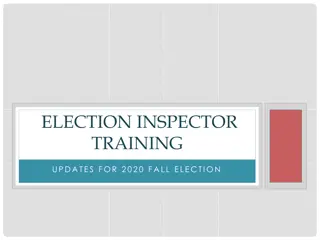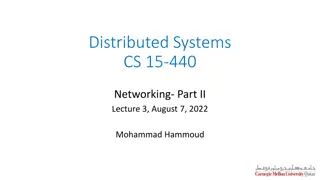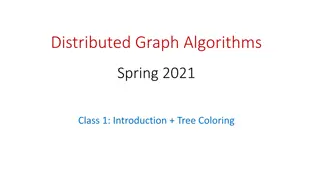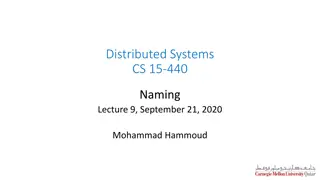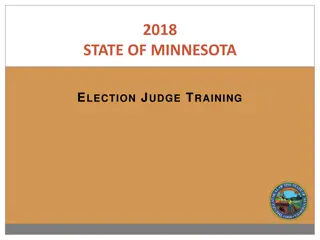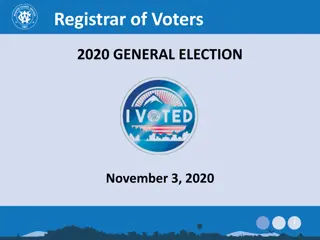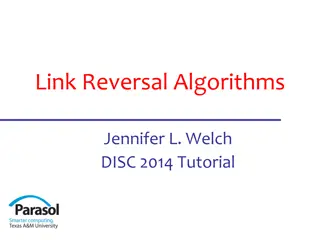Distributed Election Algorithms Overview
Distributed algorithms play a crucial role in ensuring the reliability and coordination of processes in a networked system. One essential aspect is the election algorithm, which selects a special process to act as a coordinator when needed. This overview covers the Bully Algorithm examples and analysis, as well as the Ring Algorithm for selecting a new coordinator in a logically ordered ring of processes. Explore the mechanisms, scenarios, and message exchanges involved in these election algorithms for distributed systems.
Download Presentation

Please find below an Image/Link to download the presentation.
The content on the website is provided AS IS for your information and personal use only. It may not be sold, licensed, or shared on other websites without obtaining consent from the author.If you encounter any issues during the download, it is possible that the publisher has removed the file from their server.
You are allowed to download the files provided on this website for personal or commercial use, subject to the condition that they are used lawfully. All files are the property of their respective owners.
The content on the website is provided AS IS for your information and personal use only. It may not be sold, licensed, or shared on other websites without obtaining consent from the author.
E N D
Presentation Transcript
Graphics With R Data Science Seminar November 19, 2018 Steve Gollmer
What is R? Lisp LISt Processor McCarthy (1958, MIT) Use recursive functions of symbolic expressions Lambda Papers Development of Scheme (1975-80, MIT) Treat computation like evaluating mathematical functions S Chambers (1975, Bell Labs) Interactive environment for statistical computing R Ihaka and Gentleman (1992, U of Auckland, NZ) Scheme inspired implementation of S S
# Calculate Factorials to 10 for( j in 1:10) { n <- j val <- 1 while( n > 1) { val <- val*n n <- n - 1 } print( paste(j, "! = ", val, sep="" )) } 1! = 1 2! = 2 3! = 6 4! = 24 5! = 120 Basic R syntax Every statement in R is a function call Func( arg1, arg2, arg3, ) Comments start with # Assignment statements use <- rather than = Preferred designation for strings is string , but string is acceptable Conditionals if(), else Loops For(), while(), break
Making and Accessing Lists Command a 1 2 bug TRUE b [1] 1 2 3 4 5 6 7 8 d [,1] [,2] [,3] [,4] [,5] [1,] 1 5 9 13 17 [2,] 2 6 10 14 18 [3,] 3 7 11 15 19 [4,] 4 8 12 16 20 a[3] [1] bug d[3,4] [1] 15 d[3,] [1] 3 7 11 15 19 d[,3] [1] 9 10 11 12 # Assign a list a <- c(1 , 2, bug , TRUE) a b <- c(1:8) b d <- array( 1:20, dim=c(4,5)) d a[3] d[3,4] d[3,] d[,3]
freq nocore 0.03984 0.05296 0.05876 0.06609 0.07616 0.07982 0.09293 0.1015 0.1042 0.1082 0.111 0.1138 0.1165 0.1171 0.118 0.1158 0.1107 0.1021 withcore 0.02885 0.03648 0.04289 0.05418 0.06517 0.07799 0.1152 0.1543 0.1812 0.2117 0.2077 0.1784 0.1354 0.114 0.08806 0.0789 0.05998 0.04869 9.77 13.02 16.28 19.53 26.04 29.3 39.06 52.08 61.85 74.87 91.15 113.9 146.5 179 227.9 273.4 345.1 446 Data Frames Dataframes are tables of labeled factors Import data from CSV file a <- data.frame( read.csv( lrc.csv ) ) Plot the data Plot( a )
Basics Graphics in R Line Plot # Demonstrate visual features of R graphics a <- data.frame( read.csv("lrc.csv")) attach( a ) plot( freq, nocore, xlab="Frequency (Hz)", ylab="Current (A)" ) lines( freq, nocore) title( "LRC Resonance Curve - No Core" ) detach( a )
par() Query or Set Graphical Parameters Common Parameters bg Background color fg Foreground color lwd Line width lty Line type col Color of item cex Magnify text and plotting symbols pch Symbol or letter used for plotting data log Plot axis on logarithmic scale Making changes Use parameters within plot() for one use Use par( bg = black ) for multiple uses par( bg="gray22" ) par( fg="yellow" ) par( col.axis ="white") par( col.lab ="white") par( col.main ="white") par( cex = 1.2 ) par( family="serif")
plot( freq, nocore, xlab="Frequency (Hz)", ylab="Current (A)", ylim=c( 0, 0.30 ), log = "x", col="green", lwd=2, type="l") points( freq, nocore, col=c(1:5), pch=c(1:6)) lines( freq, withcore, lwd=2, col="purple" ) points( freq, withcore, pch=19, col="yellow" ) title( "LRC Resonance Curve" ) text( 100, 0.05, "With Core", col="yellow") text( 20, 0.28, "No Core", col="green")
#Split screen into two regions split.screen( c(1,2) ) Using multiple divisions on the canvas Split the screen into regions Split.screen( c(1,2) ) 1 Row, 2 Columns Example from lrc.R Non-linear curve fit applied to data #Plot the original data screen( 1 ) plot( freq, withcore, xlab = 'Frequency (Hz)', ylab = 'Current (A)', main = 'LRC Circuit With Core') #Plot the fitting curve modfit <- lrccurveA( q ) lines( freqA, modfit ) #Plot the original data screen( 2 ) plot( freq, nocore, xlab = 'Frequency (Hz)', ylab = 'Current (A)', main = 'LRC Circuit No Core') #Plot the fitting curve modfit <- lrccurveA( p ) lines( freqA, modfit ) #Close the split screen close.screen(all = TRUE)
Other Plots Correlation Plot From 10BandAnalysisNew.R # Correlation Plot library( corr ) # Generate a correlation matrix from the satellite spectral bands datacor <- cor( satdata, use="complete.obs") # Visualize the correlation matrix using corrplot corrplot( datacor, method="ellipse" )
Saving graphics as PDF or bitmap From MovieFrameDataField.R Process Open a new device with a specified resolution. Generate plot Save results of the device to an output file (PDF, PNG, ) # Set up the graphics device so it matches the PNG image dev.new( width=imagewidth, height=imageheight, res=imageres ) # Plot data plotdatamap( ptitle, keylabel, ncMatrix, range, autoscale ) # Save the image in a png format dev.print( png, file=outfilename, width=imagewidth, height=imageheight, units="in", res=imageres)
# 3D Plot Examples library( lattice ) x <- seq(0, 6, by=0.15) y <- seq(0, 6, by=0.15) grid <- expand.grid(x=x, y=x) for( i in 1:(length(x)*length(y))) { grid$z[i] <- sin(grid$x[i])*cos(2*grid$y[i]) } levelplot(z~x*y, grid, contour=TRUE, regions=TRUE, col.regions=rainbow(100), cuts=10) wireframe( z~x*y, grid) wireframe(z~x*y, grid, drape=TRUE, col.regions=rainbow(100)) 3D Plots Different projections Use Lattice Graphics Place data on a regular grid Plot functions levelplot() Contour plot wireframe() 3d surface
3D Plots - Contour Without Lattice graphics, use the Contour function # 3D Plot Examples with contour x <- seq(0, 5, by=0.25) y <- seq(0, 5, by=0.25) z <- matrix( 1:(length(x)*length(y)), length(x), length(y)) for( i in 1:length(x) ) { for( j in 1:length(y) ) { z[i,j] <- sin(x[i])*cos(2*y[j]) } } filled.contour( x, y, z, col=rainbow(20) ) contour( x, y, z)
keylessfilled.contour <- function (x = seq(0, 1, len = nrow(z)), y = seq(0, 1, len = ncol(z)), z, xlim = range(x, finite=TRUE), ylim = range(y, finite=TRUE), zlim = range(z, finite=TRUE), levels = pretty(zlim, nlevels), nlevels = 20, color.palette = cm.colors, col = color.palette(length(levels) - 1), plot.title, plot.axes, key.title, key.axes, asp = NA, xaxs="i", yaxs="i", las = 1, axes = TRUE, frame.plot = axes, ...) { if (missing(z)) { if (!missing(x)) { if (is.list(x)) { z <- x$z y <- x$y x <- x$x } else { z <- x x <- seq(0, 1, len = nrow(z)) } } else stop("no 'z' matrix specified") } else if (is.list(x)) { y <- x$y x <- x$x } if (any(diff(x) <= 0) || any(diff(y) <= 0)) stop("increasing 'x' and 'y' values expected") ## Plot the 'plot key' (scale): # plot.new() Customized Filled Contours ## Plot contour-image:: plot.new() plot.window(xlim, ylim, "", xaxs=xaxs, yaxs=yaxs, asp=asp) filled.contour() always includes a color key Code for filled.contour() is written in R and can be inspected. Copied the code and removed the portion generating the key. Renamed the function keylessfilled.contour() View function code by typing the function name filled.contour if (!is.matrix(z) || nrow(z) <= 1 || ncol(z) <= 1) stop("no proper 'z' matrix specified") if (!is.double(z)) storage.mode(z) <- "double" .filled.contour(as.double(x), as.double(y), z, as.double(levels), col = col) if (missing(plot.axes)) { if (axes) { title(main="", xlab="", ylab="") Axis(x, side=1) Axis(y, side=2) } } else plot.axes if (frame.plot) box() if (missing(plot.title)) title(...) else plot.title invisible() }
Phase Diagrams From DampedOscillator.R Set up differential equation describing motion Call DirectionField() to make a phase plot Call keylessfilled.contour() Overlay with contours() Add arrows for direction Examples Damped Oscillator van der Pol Oscillator
Geographic plots From MovieFrameDataField.R Add library( maps ) Use keylessfilled.contour() Set up plotting area Plot the data Add continental outlines Add latitude, longitude lines library( maps ) # Set up the axis x <- 5*(1:72)-180 y <- 4*(0:45)-90 x.at <- seq(-180, 180, by=30 ) y.at <- seq(-90, 90, by=30 ) axis(1, at=x.at) axis(2, at=y.at) box() title(main=title, font.main=2) keylessfilled.contour( palettedata, nlevels=numcontours, color=panoplypalette, axes=FALSE) # Add continent outlines map( add=TRUE, interior=FALSE, fill=FALSE, lwd=2 )
Web generated 3d plot library( R2HTML ) library( rgl ) open3d() par3d( windowRect= c(5, 5, 612, 612 ) ) Sys.sleep( 0.1 ) plot3d( cleansub[,1], cleansub[,2], cleansub[,3], col=clusters$cluster, size="2", xlab="PCA 1", ylab="PCA 2", zlab="PCA 3" ) writeWebGL( filename = "3dPCA123New.html" ) From 10BandAnalysisNew.R View 3dPCA123New.html in Firefox browser
Tidyverse Collection of R packages sharing an underlying philosophy and common APIs. dplyr grammar of data manipulation ggplot2 grammar of graphics tibble reimagining data.table readr read rectangular data tidyr standard data storage purrr enhanced functional programming To use need to install in R install.packages( tidyverse )
ggplot2 Developer Hadley Wickham (2005) Use Grammar of Graphics (Wilkinson, 2005) Break graph into semantic components or layers Stats Statistical transformations Geometries Types of plots or representations of the data Aesthetics Visual property like size, shape and color of points Facets Set up multiple graphs Connect layers with + Pipe a sequence of steps on one object with %>%
# ggplot2 Example # https://www.r-graph- gallery.com/portfolio/ggplot2-package/ library(ggplot2) library(plotly) library(gapminder) p <- gapminder %>% filter(year==1977) %>% ggplot( aes(gdpPercap, lifeExp, size = pop, color=continent)) + geom_point() + scale_x_log10() + theme_bw() ggplotly(p)
The R Graph Gallery Examples of R Graphics Sample code Illustrate different packages Other Resources at the site GGPlot2 Examples Python Examples https://www.r-graph-gallery.com/
